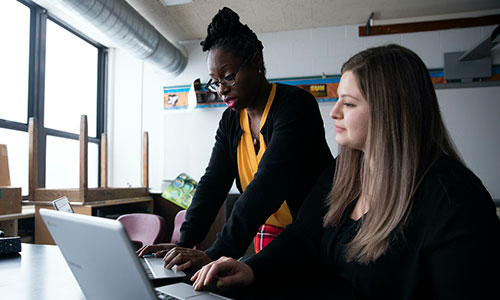
Over the years, I’ve experienced some amazing displays of learning. I’ve taught preschool, led elementary after-school programs, run summer programming for middle-schoolers, tutored and coached high-schoolers, been a college faculty member, and volunteered in adult education. Across these settings, I’ve encountered people who advanced their own learning in unique ways. And I’ve always found it interesting to ask, how do they do it? What motivates their self-directed learning?
If you’re also curious about what drives students as they learn, you could dive into academic research on the psychology of motivation and learning. It’s fascinating. But if you want to skip ahead and observe what some of this research looks like in real life, there’s no better place than a certain sixth-grade math classroom in Schiller Park, Illinois. This classroom features a self-directed learning model in which students work autonomously, consult and collaborate with each other, and draw support from their teacher.
In fact, self-directed learning works so well in this particular school that NWEA made Schiller Park the centerpiece of its High Growth for All research project. Based on what’s working in successful schools, this project aims to give educators tools and insights to tackle inequities in the classroom and enter a new era where all students attain the growth they deserve.
High Growth for All is based in rigorous research, but it’s not just a theoretical framework. It’s the foundation for a suite of best practices called the Transformative Ten. In this article, I’ll explore one of these transformative strategies that has worked in Schiller Park and many other places: creating opportunities for self-directed learning.
The building blocks of self-directed learning
Many teachers have seen with their own eyes that students who engage in self-directed learning can make great progress. But how does it work? To understand this, let’s unpack the psychological model behind this practice: self-determination theory, as laid out in the 1970s by Deci and Ryan and elaborated on by many other researchers since.
There are many touchpoints you can use to make sure self-directed learning takes place in a context of collaboration, sharing, support, and alignment.
Deci and Ryan built their theory on one big insight: while external factors can certainly help motivate people—who doesn’t like earning a paycheck or getting good grades?—the most meaningful and lasting sources of motivation typically come from within. And when we explore what fuels and sustains this sense of motivation, we find three main components: autonomy, relatedness, and competence. These are the building blocks of self-directed learning.
Let’s consider each of these components and explore how you can begin putting them to good use in your classroom. I’ll also note some potential barriers and how you can surmount them.
The power of autonomy
We don’t need research to tell us what teachers find every day: intrinsic motivation is the key to autonomy. Of course, there are always external expectations in place, and students will often gain satisfaction from meeting or even exceeding these expectations. But as you tap into students’ own inner drives, their capacity for self-directed learning increases dramatically.
That’s because students love to direct their own development through their interests and needs, and this is especially true as they get older. If we want them to really embrace the learning process and their own pursuit of it, setting them up to work autonomously, based on their own interests, is the way to make this happen.
Here are some practical ways to promote autonomy in the classroom:
- Get to know your students and their personal interests. When you have a sense of what your students care about and you can connect their interests to the task at hand, that’s a great way to supercharge learning. (This is especially true of writing, as my colleague Kayla McLaughlin notes in “4 ways to get students excited about writing.”)
- Recognize students’ successes. When students are encouraged to celebrate and reflect on their own successes, they come to think of themselves as successful—and they expect that success will continue to be theirs. This kind of mentality, in which students have the confidence that what they need already lies within them, is key to autonomy.
- Know when to turn things over to your learners. The Gradual Release of Responsibility Model framework explains why, how, and when to grant students responsibility for their own learning. You can put this framework into practice by frequently considering when learners are ready for you to turn over a task to them. It might be within a unit, within a term, or over the course of a whole school year—and, of course, it will vary from one student to another. As you engage in this reflection consistently, you’ll set your students up for successful, sustainable self-directed learning.
Relatedness is all about connection
School is a social environment, and students have a deep-seated need to form and maintain relationships—with their peers, certainly, but with teachers as well. When we draw on this need for relationships, we can find new ways to promote self-directed learning that will happen not in isolation, but in the context of a social and collaborative environment.
Why does this context matter? Because without these social bonds, students have a harder time accessing the support and help they need—and these are necessary in the classroom, especially in the context of self-directed learning. So how can teachers promote relatedness?
- Demonstrate respect for students. Know more than just their names. Know who they are. Include many opportunities for students to find themselves represented in what they’re learning.
- Connect with students. Provide frequent chances for students to show you their personal connections to and interest in what you’re teaching.
- Focus on culture and climate. Create a classroom culture that encourages students to interact with and support each other, while avoiding competitiveness and any social divisions that may erect barriers between students and the support they need to fulfill their own potential for self-directed learning.
Competence: The art of having what it takes
Does a student have the knowledge, judgment, and skill needed to pursue a given task? That, in a nutshell, is the definition of “competence.” A competent student has what it takes to achieve a reasonable goal set out before them. And when that sense of competence is developed, they often feel a sense of mastery over their learning.
However, any student can have the wind taken out of their sails. If a task is too challenging or advanced, or if they receive negative feedback (or no feedback at all, which can sometimes be even worse), their sense of competence can take a hit. As doubt creeps in, self-directed learning may stall. Here are some ways to build and sustain competence in your students:
- Establish and share clear criteria for success. Students need more than an ultimate goal or endgame. They need continuity between the present and a successful future. To accomplish this, create rubrics to outline criteria for success and, more informally, plan a series of conversations or check-ins to help students focus on progress toward learning targets.
- Think ambitious, but achievable. If you give a learner something that is genuinely too hard for them or that they’re not ready for, your effort to instill competence and confidence may backfire.
- Trust the data. As you build students’ capacity for self-directed learning, you’ll need reliable information about what they know and how they’re growing. Data from assessments like MAP® Growth™ can help you track students’ accomplishments as you implement a self-directed learning approach in your classroom.
- Trust your own expertise. Your own training and experiences provide essential information about how to support your students. As you reflect on what you know about them and use formative assessment to learn more, you can help students achieve and maintain a strong sense of competence in their own capacity to learn and excel.
But the standards! (and other concerns)
As students travel their own personal learning paths, you may find yourself concerned about how to keep all that learning aligned to the standards you’re expected to address. How can you be sure every student is engaging with grade-level content that aligns to standards and not clicking through content that’s only tangentially related to the standards, if at all?
There are three main steps to addressing this proactively: be clear, implement structure, and gather feedback consistently.
- Be clear. State your standards and goals clearly and directly at the outset, both for yourself and your students. Make sure every learner understands the assigned task before engaging with it. If you achieve clarity at the outset, you’ll be prepared to let students do their own thing. You could think of it in the context of the backward design process: start with where you want to end, and then plan learning backward from there.
- Implement structure. Students learn best when they have a dependable routine to follow. As you focus everyone on the same shared goals, targets, and standards—and the same shared academic vocabulary—think about developing a predictable cadence that you can repeat again and again. Stick to this process as you introduce and work through new tasks.
- Gather feedback consistently. Remember, a learning process has an arc. It’s important to spend time with what happens in the middle, not just the beginning and the end. Implement regular check-ins at the individual, small-group, and whole-class level—whatever it takes to get a sense of how students are doing and where they might need to be redirected. Toward the end of the time you’ve allotted for an assigned task, be sure to get a sense of where your students are in their learning, whether that’s built into the technology you’re using or achieved through other formative assessment strategies.
On their own, but not alone
Even when equipped with the tips and best practices I’ve shared, teachers may think, “Self-directed learning sounds great, but if I set my students loose to do their own thing, how in the world will I keep them on topic and on task?” It’s important to remember that self-directed learning is not necessarily an entirely independent process.
Whether it’s engaging students in a discussion about the class’s shared academic vocabulary, checking in with individual students, or taking the pulse of small working groups throughout the classroom, there are many touchpoints you can use to make sure self-directed learning takes place in a context of collaboration, sharing, support, and alignment. With each task, emphasize how, as your students direct their own learning, each one of them is helping to push the group toward achieving shared academic goals, mastering the standards, and accomplishing successful outcomes they can all be proud of.
In the end, remember that self-directed learning is about practical approaches to autonomy, relatedness, and competence. As an educator, you’re the expert on what works for your students in your specific classroom. Trust your training and experiences as you implement these strategies for self-directed learning, and your students will thank you for the opportunity to author their own experiences.






